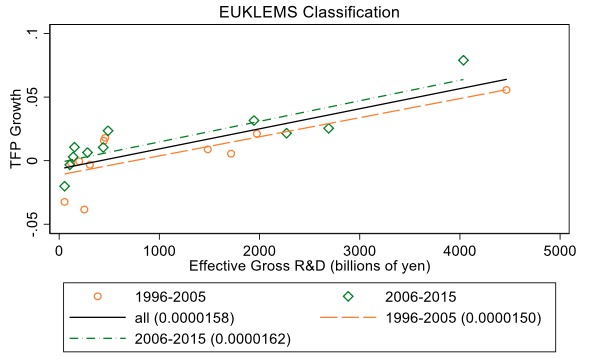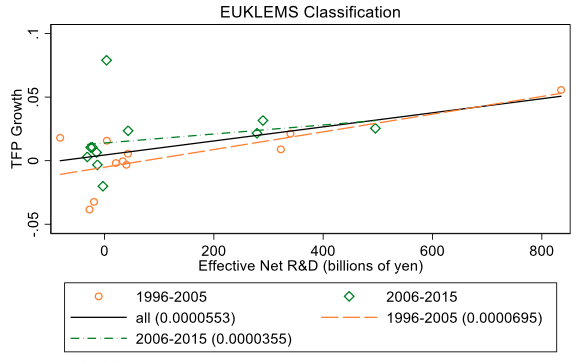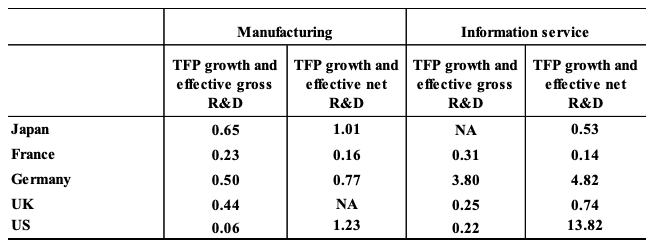The secular stagnation in the US after the Global Crisis is a topic of frequent and active discussion. On the demand side, Summers (2015) emphasised the role of fiscal policy as a means to recover from this stagnation. On the other hand, on the supply side, academic economists have focused on the slow potential growth or slow productivity growth in the long run. The optimistic view developed by Brynjolfsson and McAfee (2014) and Aghion et al. (2019) is that the perceived slow productivity growth is caused by the mismeasurement of quality in new services generated from technological progress, similar to the Solow paradox in the 1980s. The pessimistic view addressed by Gordon (2016) is that the acceleration of productivity growth resulting from the revolution in information and communication technology is now over. Bloom et al. (2019) also argue that the decline of efficiency in research and development (R&D) has led to slow productivity growth.
In a typical endogenous growth model, the growth rate in total factor productivity (TFP) is expressed as follows,
In Equation (1), we usually assume that R&D efficiency is constant. However, Bloom et al. (2019) show that R&D efficiency has declined in several fields of technological progress such as semiconductors, agriculture, and new molecular entities.
R&D efficiency in Japan
Following Bloom et al. (2019), in a new paper we measure R&D efficiency at the industry level in the twenty years from 1995 to 2015 using the Japan Industrial Productivity database and the EUKLEMS database (Miyagawa and Ishikawa 2019). Two main findings have come out of our study. First, we find positive R&D efficiency following the above equation in the manufacturing sector in Japan. Second, the decline of R&D efficiency in the Japanese manufacturing sector is slower than in other advanced countries. However, in the information service industry, we find a drastic decline of R&D efficiency in Japan.
A standard growth model assumes a constant and positive R&D efficiency. We plot the TFP growth rate and effective R&D expenditures in each manufacturing industry in Figure 1, using the Japan Industrial Productivity database. Effective R&D, which corresponds to the number of researchers in the above equation, is measured by the R&D expenditures divided by the wage rate. The positive slope in Figure 1 implies that R&D efficiency is positive. We divide the measurement period into two sub periods; the first period is from 1995 to 2005 and the second from 2006 to 2015. The slope of the second period appears to be almost same as that in the first period, implying that R&D efficiency has not yet declined in the Japanese manufacturing sector.
Figure 1 Relationship between TFP and effective gross R&D
Note: Coefficient of fitted lines are in parentheses.
In Figure 1, we use effective gross R&D expenditures which may generate a negative R&D efficiency when we find negative TFP growth and gross R&D expenditures. However, when we replace the effective gross R&D expenditures with effective net R&D expenditures -- which is measured as the change in R&D stock -- the possibility of negative R&D efficiency decreases. This is because the negative net R&D expenditures caused by the decline of R&D stock coexists with negative TFP growth rate and it generates positive R&D efficiency. Figure 2 shows the relationship between the TFP growth rate and the effective net R&D expenditures. In Figure 2, we also observe a positive slope, which implies positive R&D efficiency. However, when we divide the measurement period into two subperiods, we find different results compared to Figure 1. In Figure 2, the slope in the first period is steeper than that in the second period, implying that R&D efficiency has recently declined in the Japanese manufacturing sector.
Figure 2 Relationship between TFP and effective net R&D
Note: Coefficient of fitted lines are in parentheses.
Comparison with other countries
We extend our measurement to other advanced countries using the EUKLEMS database. Our measurement results are shown in Table 1. As shown in Figures 1 and 2, we again divide the sample period into two periods, from 1996 to 2005 and from 2006 to 2015. However, the starting years for Germany, the UK, and the US are different from Japan and France. The starting years of Germany, the UK and the US are 1997, 1999 and 2000, respectively. In addition to the manufacturing sector, we also measure the R&D efficiency in the information service industry.
Table 1 Measurement of R&D efficiency
Sources: JIP 2018 database and EUKLEMS database
The output in Table 1 shows the ratio of R&D efficiency in the second period to that in the first period. Where the value is less than 1, it shows that R&D efficiency has recently declined. Table 1 shows that R&D efficiency has declined from the first to the second period in the manufacturing sector in all countries, when we use data on the TFP growth rate and effective gross R&D expenditures. In Japan, the rate of decline in R&D efficiency is the lowest of these advanced countries. On the other hand, the rate of decline of R&D efficiency in the US manufacturing sector is the highest. However, when we measure R&D efficiency using data on TFP growth data and net effective R&D expenditures, we find that R&D efficiency in both Japan and the US have increased. These results imply that the accumulation in R&D assets has slowed significantly in the second period in both countries. In the case of the UK, N.A. implies negative R&D efficiency, as growth in R&D assets is negative in spite of positive TFP growth.
In the case of information service, we are not able to estimate the change in R&D efficiency measured by the TFP growth rate and effective gross R&D expenditures in Japan, because the TFP growth rate in this industry in the second period is negative. In other advanced countries except Germany, R&D efficiency declined in the second period. However, we are able to estimate the change in R&D efficiency measured by TFP growth and effective net R&D expenditures in Japan, because both factors in R&D efficiency are negative. We find that the rate of decline of R&D efficiency in Japan slowed significantly in the second period. For other advanced countries, the rate of decline of R&D efficiency in the information service is less than in the manufacturing sector. As a result, Japan shows differing patterns in the decline of R&D efficiency compared to other advanced countries.
The above measurement does not take into account other factors that affect R&D efficiency. Although we expect that investment in information and communications technology and the liquidity/asset ratio would contribute to R&D efficiency, our econometric studies do not support our hypothesis.
Policy implications
Governments in advanced countries have raised their expenditures in R&D to improve productivity growth. However, our study shows that raising R&D expenditures is not sufficient for productivity growth in the context of declining R&D efficiency. The decline of R&D efficiency is a serious problem in Japan in particular, because the Japanese government is running huge government deficits. To reverse the ongoing decline of R&D efficiency, we have two suggestions. For the research sector, the government or research institutions should promote international collaboration in several fields of research. For the business sector, firms should utilise open innovation, meaning that firms generate new products or new processes using innovations that are generated outside of those firms. Otherwise, Japan will not be able to compete with the US and China in all areas of science. Like the Clinton administration in the US, which suspended the Superconducting Super Collider Project in favour of the revolution in information and communications technology, Japan should also be carefully selecting the research fields for the near future.
References
Aghion, P, A Bergeaud, T Boppart, P Klenow and H Li, (2019), “Missing growth from creative destruction”, The American Economic Review 109(8): 2795-2822.
Bloom, N, C Jones, J Van Reenen and M Webb (2019) “Are ideas getting harder to find?” Version 3.0, Stanford University.
Brynjolfsson, E and A McAfee (2014), The second machine age: Work, progress, and prosperity in a time of brilliant technologies, New York: W. W. Norton.
Gordon, R J (2016), The rise and fall of American growth: The U.S. standard of living since the civil war, Princeton University Press.
Miyagawa T and T Ishikawa (2019), “On the decline of R&D efficiency”, RIETI Discussion Paper Series 19-E-052.
Summers, L (2015), “Demand side secular stagnation”, The American Economic Review, Papers and Proceedings 105(5): 60-65.








